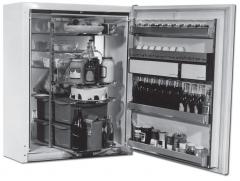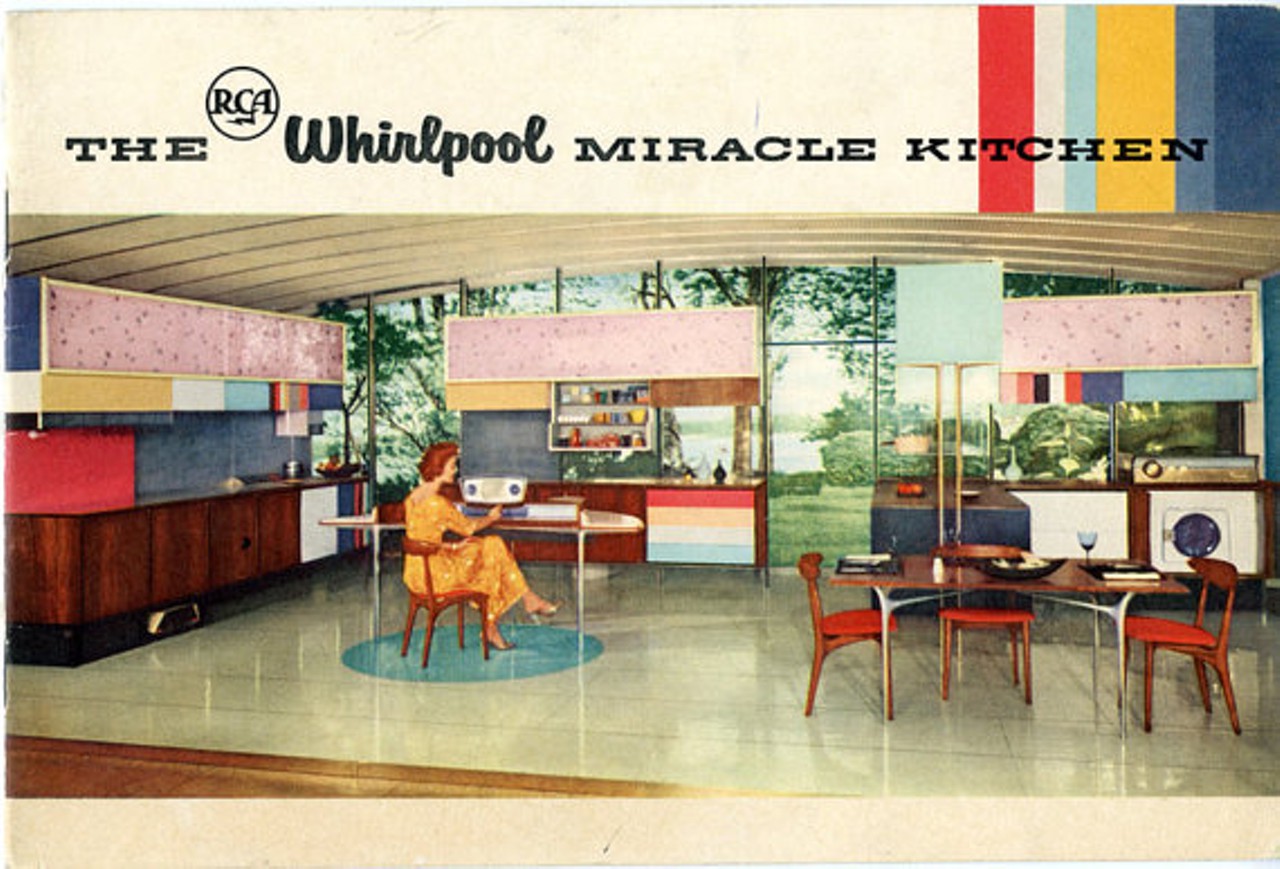By: Tom Maxwell | Posted: August 7, 2015 | Updated: April 5, 2023
Introduction: Joe Maxwell and Universal Design
Joe Maxwell is an 83 year old industrial designer who recently reached out to Tech-enhanced Life, because he has lots of design ideas and is looking for ways to get them turned into reality, and because he liked what he read on our site about collaborative creation. We are still talking about how we might work together, but meanwhile I suggested that our readers would find interesting a description of one of Joe’s Universal Design projects. Joe’s son Tom turns out to be a writer, and he was kind enough to author the article below.
I find this an especially interesting piece, because today one continually hears people talking about “Universal Design” as if it is some radical new idea. In fact, as this article illustrates, it is not at all a new idea, although still very much a good one. When you read about Joe’s kitchen design below from the 1950’s you can’t help wondering why we don’t see more Universal Design in mainstream products.
I hope you enjoy Tom Maxwell’s article below.
— Richard Caro
The Miracle Kitchen and More
My father, Joe Maxwell, is one of the last surviving members of the design team that created the Miracle Kitchen. It was the RCA/Whirlpool version of a 1950s high concept kitchen, much like others being built as proofs of concept at the height of the Atomic Age. One of these, GE’s lemon-yellow model, was the scene of the Richard Nixon and Nikita Khrushchev’s famous “kitchen debate” of 1959.
The one my dad worked on, the Miracle Kitchen, boasted many advanced technological features. It showcased a primitive microwave and a self-propelled dishwasher and vacuum cleaner. There was a “planning area” with closed circuit TV and a frozen drink dispenser. Many of these concepts are part of our everyday life; some didn’t really make it off the drawing board. It was my father’s work, however, that was so advanced – so vital even today – that it was never produced. Even as a young man in his early twenties, just at the beginning of a distinguished career in industrial design, Joe Maxwell conceived of a Universal Design kitchen.
Accessibility
If Universal Design can be described in one word, it’s accessibility. For the Miracle Kitchen, this meant countertops that could raise and lower and wall cabinets that lowered when opened, conforming to the user rather than building code. Over the next six decades, Joe has gone on to design may other component parts of a Universal Design kitchen, including carousel refrigerators and pantries, cupboards with counterbalanced doors, a pot and pan drawer, and a sit down sink – all made to be within easy reach of any user, even those working from a task chair. Once we understand that every person, of any age, exists on a spectrum of ability, the inevitability of Universal Design becomes obvious.
Refrigerator
 Joe’s next foray into accessibility for Whirlpool came a few years later, in the form of a Universal Design Refrigerator. Here, interior shelving is attached to a central revolving frame, linked to the door. When the door is opened 85 degrees, the shelving frame is pulled to the front of the unit, allowing for full 360-degree rotation of the shelves. The door can be opened a full 180 degrees, flush with adjoining cabinetry, which would pull the interior frame out past the front of the unit for greater accessibility. Rotating the shelves allows for access of any item in the refrigerator, as they will only be two deep on any given shelf.
Joe’s next foray into accessibility for Whirlpool came a few years later, in the form of a Universal Design Refrigerator. Here, interior shelving is attached to a central revolving frame, linked to the door. When the door is opened 85 degrees, the shelving frame is pulled to the front of the unit, allowing for full 360-degree rotation of the shelves. The door can be opened a full 180 degrees, flush with adjoining cabinetry, which would pull the interior frame out past the front of the unit for greater accessibility. Rotating the shelves allows for access of any item in the refrigerator, as they will only be two deep on any given shelf.
This design is a complete departure from refrigerators of the last half-century. In traditional models, only items placed toward the front of any given shelf are easily accessible. With the Universal Design Refrigerator, it is no longer necessary to put most-used items towards the front, or provide space in between shelves in order to reach items in the back, minimizing wasted space and spoilage.
All interior shelves and door components of the refrigerator are adjustable by height. Every shelf and drawer fits into a dishwasher. The interior of the unit and the door liner are completely smooth. Only one bottom shelf needs to be removed for thorough cleaning of the interior. The interior of the refrigerator is well lit. The crisper pans are smaller than traditional refrigerators, for easy removal, transport and cleaning. They can be arranged in a variety of positions inside the refrigerator. The door is symmetrical and reversible.
Whirlpool produced a proof of concept for the carousel refrigerator, but did not put it into production, despite its obvious advances. After leaving the company, Joe received a letter from Bill Hume, Whirlpool’s product manager. He thanked Dad for his work and explained why the carousel refrigerator Dad designed was never put into production. “If in looking back on your efforts I were to assign any weakness to them,” my father was told, “it would be that they were too far in front of the industry. The Carousel concept is the most flexible interior ever designed but we have concluded it is too far advanced by relation to our competitors to gain the broad acceptance we feel necessary.” In other words, the product was too ahead of its time.
Kitchen pantry
Similar design elements are featured in the Universal Design kitchen pantry: revolving shelves attached to a center post, brought out into the room by fully opening the door. Making the height of this unit adjustable allows for maximal accessibility. This pantry provides so much linear feet of shelves that most cabinets found in a typical kitchen are not needed. This is just as well – today’s kitchen cabinets are scarcely accessible for people with limited range of reach.
The mechanics required for adjustable height pantries and countertops is elegant and inexpensive. There are two water tanks, one in front of and one behind the wall for counterbalance – one being empty and one being filled as necessary, supplemented by a spring similar to what is found on a garage door. Once unlatched, the module will rise slowly on its own, or lower with a small amount of pressure from the user. Once the desired height is achieved, the module locks into place.
In this manner, not only can pantries rise or lower, depending on the height of the user – so can entire countertops, with sinks, cook tops, drawers and built-in exhaust fans. Lined with useful and attractive handrails, these countertops maximize support and safety.
Let’s take a closer look at this particular set up. On the left and right side of the countertop are induction cook tops. Cooking vessels are heated by magnetic induction, rather than thermal conduction, as from a gas flame or electric heating element. This greatly reduces the risk of injury. Programmable sensors can monitor the station, shutting off the heat to empty cooking vessels, virtually eliminating potential fires.
In the middle of the countertop is a grease sink. Used pots can be slid over to it, and their contents dumped out. A disposal will take care of grease and particulate matter. This way, the lighter cooking vessels can be transported over to nearby serving vessels or the sink or dishwasher.
Underneath the countertop are drawers for various utensils. There is also plenty of legroom for those working at the space while seated. On one side is the pots and pans drawer. This is a simple, sturdy affair: the drawer pulls out on heavy rails. Cooking vessels can hang on eyehooks fixed along a central metal rod by their handles. There is no need to root around in bottom drawers or in the back of pantries. All of these drawers are part of adjustable height countertop system.
Above the countertop, and able to be raised and lowered along with it, is a cupboard. It is a typical space for storage with this one exception: its door is also counterbalanced. With a small amount of effort, it will mostly raise itself up and out of the way. When raised, most of the door fits inside and along the top of the unit, with very little protruding into the room. There are no open cupboard doors to hit one’s head on, as is to typical in most kitchens.
Sink
The last component in the Universal Design kitchen to describe is the manual dishwashing stem as a component of the sit down sink. It contains two sinks with a garbage disposal between them and a cutting board that fits at the top of either sink so that scraps can be scraped over easily. The manual dishwashing system would be used to wash the few dishes that would not be enough to fill the dishwasher. There is a side for soapy water and a side for rinsing. Water in each sink would be pumped, and recycled while washing and rinsing with the two separate faucets. The sinks are shallow nearest to the user to provide knee area for sitting. Water comes from a coiled gooseneck faucet, with a detachable sprayer. Drain boards on either side of the sink that actually can hold dishes waiting to be cleaned and those drying on a rack. As with a dishwasher, the sinks are drained by a pump that moves water to a garbage disposal. All of these features are in easy reach of the user.
Lifelong useability
Joe Maxwell’s Universal Design kitchen exists at the intersection of profit and the public good. Kitchens are a large return on remodeling investments, and this kitchen is designed for a succession of users operating on a spectrum of ability – so it will work for the life of the user. The modules are discrete and can be bought and installed separately, or put together to make a unified whole. They can be produced in an endless number of attractive veneers and colors, while all the while embodying the timeless design imperative of what works best. It is the product of years of supplementation and refinement, and its time is now.
Joe Maxwell’s Bio
 Joe Maxwell is an inventor and industrial designer. He is a graduate of Auburn University and the University of Illinois. Before becoming self-employed, Joe worked at GM Styling and Sundberg-Ferar. His many career highlights include working on the RCA/Whirlpool Miracle Kitchen, the perennially popular Tampa Airport, the Phoenix Sky Harbor airport, and the Erlanger Medical Center in Chattanooga, Tennessee.
Joe Maxwell is an inventor and industrial designer. He is a graduate of Auburn University and the University of Illinois. Before becoming self-employed, Joe worked at GM Styling and Sundberg-Ferar. His many career highlights include working on the RCA/Whirlpool Miracle Kitchen, the perennially popular Tampa Airport, the Phoenix Sky Harbor airport, and the Erlanger Medical Center in Chattanooga, Tennessee.
Joe has a particular interest in accessibility and effective Wayfinding, which has led to his work on cluster seating and a Universal Design kitchen. Joe won a Gold 1995 IDEA Award for the Wayfinding and Effective Communications Research done for The Tampa International Airport. That airport was voted the best liked airport in the world by frequent flyers for around a decade.
*Disclosure: The research and opinions in this article are those of the author, and may or may not reflect the official views of Tech-enhanced Life.
If you use the links on this website when you buy products we write about, we may earn commissions from qualifying purchases as an Amazon Associate or other affiliate program participant. This does not affect the price you pay. We use the (modest) income to help fund our research.
In some cases, when we evaluate products and services, we ask the vendor to loan us the products we review (so we don’t need to buy them). Beyond the above, Tech-enhanced Life has no financial interest in any products or services discussed here, and this article is not sponsored by the vendor or any third party. See How we Fund our Work.


